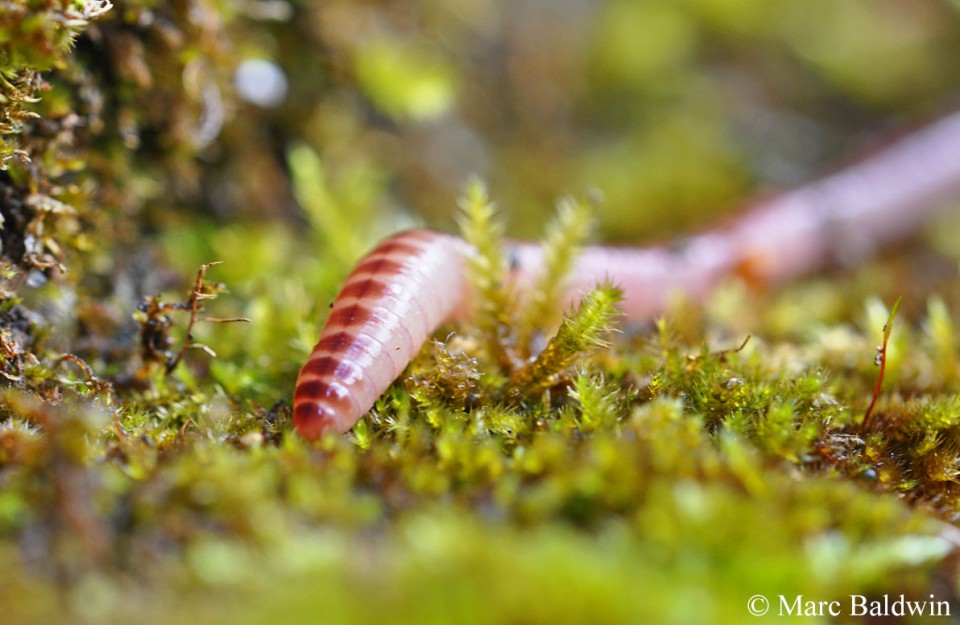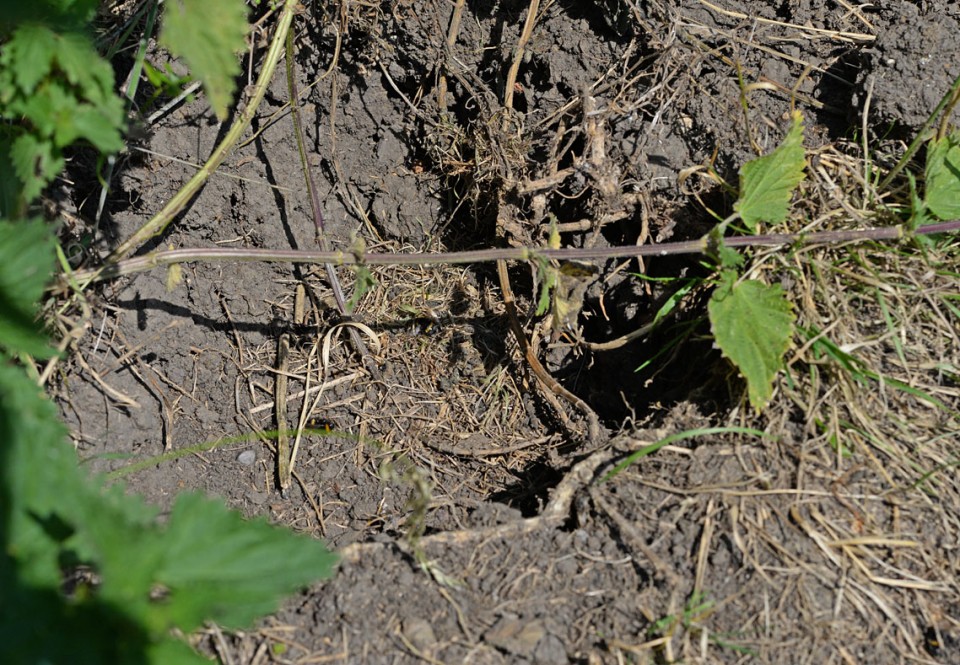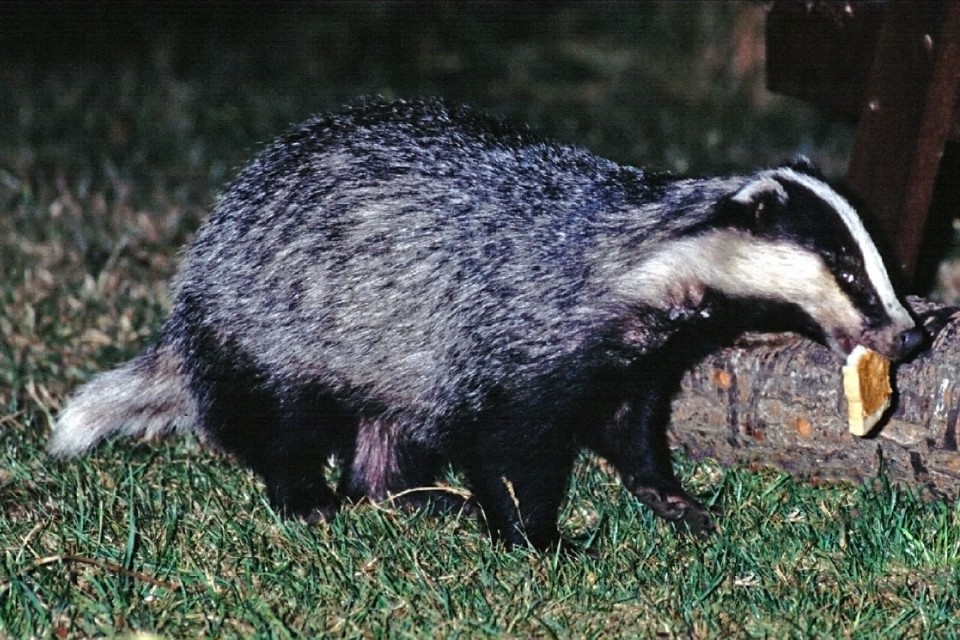European Badger Food & Feeding Behaviour
After the winter hiatus, "normal" feeding resumes and even where large clans persist, individuals typically forage solitarily. Tracking studies have demonstrated that clan members will often use the same feeding sites at different times throughout the night and that badgers tend to move from sett to sett within their range, only rarely straying into a neighbouring territory. Interestingly, badgers are more likely to be found feeding alone during the spring, becoming gradually more social as the year progresses. Regular social feeding is common by about May and whole clans may forage together during the autumn.

The feeding regime of the badger may be influenced by prevailing weather conditions and in his book, Badgers, Michael Clark notes that gales make feeding badgers nervous -- this is a common observation among mammals and strong winds presumably make detection of potential threats by scent more difficult.
Badgers are variously described as opportunistic omnivores or local specialists. Throughout much of their range (and across the entire UK) they feed primarily on oligochaetes (earthworms). One 1981 study on badgers from six areas in Scotland, for example, concluded that the dominant food at every site was earthworms (Lumbricus terrestris and L. rubellus). Similarly, a study on a population of badgers in southwest Britain found that 75% of individuals had worms in their stomach, with 57% containing virtually nothing but worms. Various authors report that it is not uncommon for a single adult badger to eat 200 earthworms per night, especially on warm, still, damp nights, which make for excellent worming. Indeed, throughout much of their range, earthworms comprise about half of the badger's diet, while mammals and insects constitute about 10% and 15%, respectively.

In his fascinating book, Badgers' Year, Howard Lancum described the results of feeding experiments he conducted with the various tame badgers he'd raised, as well as wild animals at a sett he was observing during the spring and summer of 1952 in Devon. Lancum found that badgers were "inordinately fond" of wasp grubs, preferring them to any other food offered, with raw rabbit liver and honey close in second and third place. The wild badgers avidly took honeycomb. Various beetles were accepted, as well as some fruits and vegetables (e.g., turnip and potato). Slugs and snails were also eaten with some relish. Indeed, Lancum described the "yelps of joy" uttered by two cubs upon discovering half a bucket's worth of snails left by the sett. According to Lancum they "polished off the lot in just over five minutes", the crunches being plainly heard from his hide several metres away.
Birds & mammals
Badgers may also take birds and their eggs, although precisely how significant they are as an avian predator is still a matter of debate. Anecdotal evidence, largely from the 1940s and 1950s, suggests that badgers may occasionally be responsible for heavy losses of gamebirds and it appears that in years when their preferred food is scarce, badgers may take more birds. There is little in the way of documentary evidence to support these notions, however, and from the numerous studies looking at the diet of badgers across their range, it seems that birds are an uncommon addition to their diet. On 27th June 2022, Paul Coombes and Nick Bristow captured some intriguing behaviour from a badger on the trailcamera they had setup on a nightjar's nest in Nottinghamshire. The badgers sniffed intensively at the nest and even picked up one of the eggs before dropping it, sniffing around the nest again, and leaving the nest. BTO biologist Greg Conway commented on the Paul's Twitter thread, recalling how badgers and foxes were the main mammalian nest predators of the 36 nests they monitored using trailcamera in Thetford Forest, never leaving anything behind.

A study by the Department for Environment, Food and Rural Affairs (DEFRA) found that out of 289 calls regarding "nuisance badgers" in 2001 and 2002, only seven (2.4%) concerned predation on domestic fowl. Moreover, in an extensive review of records of birds in the diet badgers, Tim Hounsome and Richard Delahay of the Central Science Laboratory in York report that bird remains were recorded in 2,038 out of 36,699 stomach content and faecal analyses in the literature, representing 5.5% overall, or roughly 8% when considering only UK records. They also found that, although the percentage frequency of occurrence of birds in the diet increased significantly with latitude, there was no obvious connection between the presence of birds in the diet and season. Hounsome and Delahay, in conjunction with several other authors, suggest that many of the bird remains found could have been scavenged carrion, making it difficult to assess the potential impact of badgers on bird populations.
Badgers will actively predate rabbits (Oryctolagus cuniculus), which are neatly skinned to leave only the stomach and caecum, and are one of two British hedgehog-eaters (the other being the Red Fox); foxes tend to eat the skin of the hedgehog, while badgers leave it (see QA). Apparently, bearing witness to hedgehog predation is not something for the faint-hearted. In his Wildguide, acclaimed wildlife photographer and presenter Simon King wrote:
"Of all the predators in Britain, badgers seem best equipped to deal with hedgehogs as a meal, digging a shallow pit next to the curled pin-cushion, rolling it in with muzzle or fore feet, and then using enormous power and long front claws to prize open the packed lunch. This whole procedure is usually punctuated by very loud and pitiful screams and grunts coming from the terrified hedgehog."
Badgers have sometimes been accused of killing livestock, particularly lambs and chickens, although the evidence appears weak. As opportunists, badgers seldom pass up the opportunity for an easy meal but to suggest this behaviour is anything other than occasional would be an exaggeration, based on the current evidence. Indeed, veteran badger-watcher Mal Ingham has a collection of trailcam videos showing badgers and sheep, even relatively small lambs, interacting peaceably at his sett in Wales. Similarly, in Badgers' Year, published in 1954, Howard Lancum tells how, during the 34 years leading to the writing of his book, he had investigated 109 cases of poultry killing, in hen houses and other enclosures, by wild animals from Cornwall to Kent:
"Of these, in 92 cases I was able to prove beyond reasonable doubt that foxes were the culprits; in 15 cases the killers could not be identified with certainty; in only two were badgers proved to be guilty. The total number of birds killed in the 92 fox cases was 552, and, in the two badger cases, two."
Badgers, like most predators, will scavenge where the opportunity arises and this includes deer and sheep carcasses. There is some indication that they may scavenge the bodies of dead conspecifics (see below).
Changing with the times
Being opportunistic omnivores, the proportion of various food items varies according to location and season. A study by Eloy Revilla and Francisco Palomares published in the Canadian Journal of Zoology in 2002 found that the main food resource for badgers was young rabbits during the winter and spring, fruits in the autumn and reptiles in the summer months. The scientists also report that consumption of rabbits (both juvenile and adults) was related to rabbit abundance, with a "type-3 response". In other words, as young rabbits increased in number, badgers slowly adjusted their diet to include more of them. Thus, it seems that in their study area of Spain at least, badgers are generalists and are not locally specialized. A similar study by biologists at the Euskal Herriko Unibersitatea in Spain found that the diet of a badger clan from Biscay varied with season; fruit was a staple constituent in summer and earthworms were the main component in all other seasons.
A study of badgers in Denmark found that cereals were an important part of the diet during the spring and autumn, with small mammals more important during the summer months. This study also reported that, during the autumn, males ate twice as many earthworms as did females and that diet composition did not differ significantly with age. This dietic variation has led to considerable debate over ascribing badgers to a feeding type. I think that Carnivore biologist Hans Kruuk, formerly of Aberdeen University in Scotland, summed the situation up quite nicely in his book Hunter and Hunted, in which he wrote:
"More complicated still, the Eurasian badger, for instance, may be highly focused in its food selection in any one area, concentrating on earthworms in northwest Europe, on rabbits in southern Spain and on olives in northern Italy. There is no doubt that in each of these areas badgers are highly specialized compared with the other predators around. Nevertheless, their specializations are different in different places. There is still earnest scientific debate about whether this animal is an omnivore or a specialist (I call it a local specialist)."
If one were wishing a more cautious approach to classifying badger feeding habits, an alternative definition was given by Universidad Rey Juan Carlos' Emilio Virgós and his colleagues in their 2004 contribution to the Canadian Journal of Zoology, in which they describe badgers as:
"facultative specialists that search preferentially for earthworms but probably take other food resources during their foraging bouts (beetles, fruits, and fungi)."
Regardless of the trophic 'category' to which you choose to assign Meles meles, in most populations, badgers feed copiously in the spring and summer months and have laid down appreciable subcutaneous (under the skin) fat reserves by the autumn. This layer of fat can be considerable and may increase the badger's weight by as much as 60%. Indeed, many consider the abundance of food resources to be ultimately responsible for the great variation in badger sociality (i.e., it is the underlying cause of badgers living either solitarily or as groups); recent work from Poland and Oxford certainly seems to support this idea.
Bringing home the bacon? Carrying food back to the sett
Many carnivores carry their food away to eat away from prying eyes and frequently exhibit caching behaviour, where uneaten food is buried for later retrieval. The is broadly not the case for badgers. To the best of my knowledge, caching behaviour has never been formally recorded in this species, and I'm only aware of one report from Brian Ludwig who observed a badger bury a fatball in his garden in Edinburgh during February 2022. Typically, however, food is eaten where (or close to where) it is found. While watching badgers in Warwickshire during 2021, for example, wildlife photographer Malc Goode observed one dragging a rabbit about six metres (20 ft.) away into cover to eat. The previous year, Malc had watched a badger dragging a squirrel carcass. A handful of particularly interesting observations suggest that, occasionally, food may also be brought back to the sett.
In their 1996 opus, Ernest Neal and Chris Cheeseman recount several examples of badgers having been seen carrying food. These included a sow carrying a rabbit while accompanied by two cubs in the Netherlands, and observations on three separate occasions by Chris Ferris of sows carrying pigeons, two dead chickens and a pheasant. Neal and Cheeseman also printed a letter from badger watcher E. Darwell that included a photograph of a boar returning to its sett with an adult rabbit that it apparently took underground to eat. This last example is of particular interest because Mr Darwell reported the arrival of a fox shortly after the badger went underground that "had obviously been following the scent of the rabbit". The authors suggest that the badger may have stolen the rabbit from the fox, returning to the sett to eat it in privacy.
In 2008, the BBC Natural World documentary Badgers: Secrets of the Sett featured a badger carrying an apple back from a nearby orchard and eating it within one of the sett chambers. Subsequently, former Head Ranger and Wildlife Officer Malcolm Ingham has captured two instances of food bring brought back to the sett by badgers at his study site in north Wales. In April 2019, a badger was seen carrying an egg to the sett entrance where it was dropped and rolled down into the tunnel, closely followed by the badger. The second incidence, recorded the previous year, captured a sow returning to the sett with a young rabbit. Mal told me the sow "teased a cub with it before taking into the sett." The cubs were subsequently caught on Mal's trail cameras playing tug-o-war with the rabbit carcass. More recently, in October 2023, Andrew Walmsley captured a badger returning to a sett in the New Forest with a rabbit, taking it underground, while, in April 2025, a trailcamera set on a pool in Smokebox Wood in Hampshire recorded a badger passing by carrying an unknown prey item.

Finally, and possibly most interesting of all, is the report from Oxfordshire of two badgers dragging a newborn calf back to their sett. The report was given by Janet Orchard in a reader's letter published in the Autumn 1958 issue of The Countryman. The letter recalls the events of cold starlit morning in early spring during which a newborn calf was missing from a field. One of Orchard's farm hands took a torch and searched the field and adjacent woodland in which she found a badger sett from the entrance of which was protruding a cloven hoof. The farm hand dug the calf out and carried the body back to the milking barn, convinced the animal was dead, although Orchard thought she felt a very weak pulse. Following 20 minutes of artificial respiration she was able to revive the calf and, in her letter, Orchard wrote:
"When it was daylight, I went back to the spot where the cow had calved. From there I followed the tracks of two badgers moving backwards as they dragged the calf across two hundred yards of frosty grass, under a barbed-wire fence to which a few of the calf hairs still clung, and over ten yards of woodland to the main entrance of the set. They must have gone underground dragging the calf after them for its mouth to have been filled with sand and only one hind foot to be left above ground."
In conclusion...
Across their range, badgers will also take insects (including caterpillars and moths), beetles, small mammals (including voles, rats, mice, moles, young rabbits and hedgehogs), fish, frogs, berries, roots, bulbs, nuts, fruit (in the autumn), fungi and plant material, particularly cereals such as oats and wheat. In the UK, badgers seem particularly partial to elder berries, the seeds of which they distribute in their dung. In a similar manner to most other mammals, the scat can often provide vital clues to the diet of the animal, because different foods lead to changes in consistency. Soft scat is associated with earthworms, while more jelly-like excrement implies a predominance of berries and fruits in the diet. In some areas, badgers may dig out and eat the contents of wasp and bee nests, including the larvae, pupae, honey and honeycomb. They will eat carrion and those in urban areas are known to scavenge food from bins and gardens and may occasionally break into poultry houses or take other small domestic animals, but such instances are considered rare.